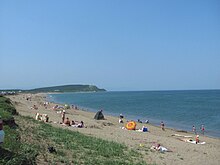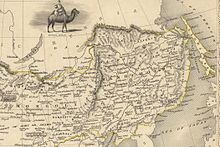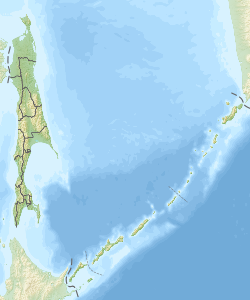Sakhalin
| Sakhalin | ||
|---|---|---|
| Environment map | ||
| Waters | Sea of Okhotsk | |
| Geographical location | 51 ° N , 143 ° E | |
|
|
||
| length | 950 km | |
| width | 160 km | |
| surface | 72,492 km² | |
| Highest elevation |
Lopatin 1609 m |
|
| Residents | 673.100 9.3 inhabitants / km² |
|
| main place | Yuzhno-Sakhalinsk | |
| Topographic map of Sakhalin | ||
Sakhalin ( Russian Сахалин [ səxɐˈlʲin ]; Manchurian ᠰ᠊ᠠᡴᡥᠠᠯᡳᡟᠠ᠊ᠠ
ᡠ᠊ᠯᠠ ᠠ᠊ᠩᡤᠠ
ᡥ᠊ᠠᡩᡩᠠ sahaliyan ula angga hada , "rocks in front of the mouth of the Black Stream"; Ainu kamuy kar put ya mosir , "island that the gods created off the mouth of the [ Amur ] river "; Chinese 庫 頁 島 / 库 页 岛 , Pinyin Kùyè Dǎo ; Japanese 樺 太 島 , Karafuto-tō from Ainu kar put ) is the largest island in Russia and the main island of Sakhalin Oblast . The capital of the Oblast is Yuzhno-Sakhalinsk . Russia's most important oil and gas reserves are located near and on the island .
geography
Sakhalin is located in the Pacific (north of Japan ) and as a border island between the Sea of Okhotsk in the north and the Sea of Japan in the south. Sakhalin is separated from mainland Russia by the 7.3 km wide Tatar Sound , and from the Japanese island of Hokkaidō by the 43 km wide La Pérouse Strait .
A traffic connection to Hokkaido is planned ( Sakhalin-Hokkaidō tunnel ).
history




Sakhalin was already settled in the Neolithic . Finds of worked flint and painted clay vessels testify to this . From the Bronze Age there are traces of man-made stone walls and earthen walls in which parts of bronze vessels, knives and spearheads have been found. The indigenous peoples who lived on the island included the Ainu in the south , the Oroken on the east coast and the Niwchen in the north .
The first written mention of Sakhalin comes from Song Lian, who wrote the Yuan Shi (History of the Yuan Dynasty) around 1370 . It mentions that from 1264 the inhabitants of the island submitted to the Mongols under the leadership of Kublai Khan . From 1308 Sakhalin belonged to the dominion of the Yuan dynasty . There is evidence that the eunuch Yishiha had a Buddhist temple built on Sakhalin in 1413 in the service of the Ming dynasty . In the period that followed, the residents of Sakhalin were in a tribute relationship with the various Chinese imperial houses . A Ming boundary stone still exists on the island today.
Until the 19th century, European cartographers and seafarers still argued about whether Sakhalin was an island at all. In 1635 members of the expedition of the Japanese prince of Matsumae went ashore in the south of the island. The first Russian “explorer” followed less than a decade later. A Cossack troop led by Vasily Poyarkov drove down the Amur to its mouth. Although it has not been proven that Poyarkov ever set foot on the island, he is considered the discoverer of Sakhalin in Russia. The presence of Japanese and Russians remained sporadic for the next two centuries. Japanese fishermen from Hokkaido Prefecture set up temporary bivouacs in Aniwa Bay . They devoted themselves exclusively to catching herring, salmon, lobster and harvesting seaweed . The fishermen did not plant any fields or farm animals, but brought everything they needed to live from their homeland. In the winter months they returned to Hokkaidō.
The Russian presence was even more volatile. The Treaty of Nerchinsk (1689) had blocked Russia's access to the Amur, without which control of Sakhalin was virtually impossible for Russia. Although Russia managed to legalize its advance into the area between Lake Baikal and Ergun under international law with the Treaty of Nerchinsk, the treaty confirmed that the entire Amur and Ussuri area and the island of Kùyè Dǎo (Russian: Sakhalin) belonged to China.
In 1787, the French geographer Jean-François de La Pérouse explored parts of the island. Due to strong winds and the shallows , he was unable to circumnavigate the northern part. Nevertheless, for the first time he mapped a large part of the strait , later known as the Tatar Strait , between the Chinese mainland and the island. He called the island "Tchoka". This designation was used in some French maps for a while. In 1805, the Baltic-Russian circumnavigator Adam Johann von Krusenstern explored the northern coast of China, but viewed Sakhalin, like La Pérouse, as a peninsula.
The first clashes between Russians and Japanese occurred at the beginning of the 19th century. Alarmed by the increasing presence of European powers in the Sea of Japan, Japanese troops occupied the island in 1806, which the Russian government refused to accept. A short time later both sides lost interest in the island. Alaska, the Caucasus and the Balkans were more important to Saint Petersburg than distant Sakhalin. The Japanese military also withdrew from 1814. In 1821 Japan officially gave up its claims to rule over the island.
After explorers from the Russian Geographical Society discovered large gold deposits on the Amur and Ussuri, Tsar Nicholas I approved further expansions in Outer Manchuria . These so-called expeditions were under the direction of Gennady Nevelskoi , who between 1851 and 1853 had several Russian settlements founded on the Amur Delta and on Sakhalin. At the beginning of 1854 the Russian government authorized the Governor General of Irkutsk , Nikolai Muravjow , to negotiate with China over the border line in Manchuria and to station large contingents of troops at the mouth of the Amur. Between 1854 and 1858, Muravyov provided military support for Nevelskoi to establish new settlements. The first fighting between Chinese and Russians took place in May 1854. The Russian military sailed downriver on 77 warships to the mouth of the Amur and occupied large parts of Outer Manchuria, including the island of Sakhalin.
In view of the competing claims, Japan had regained sovereignty over the Kuril Islands and Sakhalin in 1845 . On February 7, 1855, Russia and Japan signed the Treaty of Shimoda . Without involving the Chinese imperial family, Sakhalin was declared as common property. Specifically, this trade, shipping and border drawing treaty granted both sides the same right to dispose of Sakhalin, but left the future status of the island open. With the Treaty of Aigun (1858) and the Beijing Convention (1860), Russia forced China to cede Outer Manchuria. The Chinese imperial family lost all claims to the areas north of the Amur and east of the Ussuri, including Sakhalin. From then on, the Chinese past practically no longer played a role in Sakhalin's Russian and Japanese view of history.
As a result, Japan again claimed the island and offered Russia to buy Sakhalin. The Russian government rejected the offer. In addition, the Meiji government lacked both the unity and the military means to assert its interests in Sakhalin. At the same time, Japan's focus was on the climatically more favorable Formosa ( Taiwan ), which China, along with the Pescadors , had to cede to the Japanese Empire after the lost Sino-Japanese war . In 1875, Russia and Japan came to an agreement in the Treaty of Saint Petersburg : Sakhalin fell to Russia, and Japan in return received sovereignty over all Kurils . Russia also made extensive concessions. On Sakhalin Japan received, among other things, the right to open a consulate in Korsakow , a temporary exemption from customs duties and concessions for fishing. Resident Japanese were allowed to stay on the island and retain their nationality.
At that time one of the largest penal colonies in the Russian Empire was established on the island , about which Anton Chekhov reported in detail in his travelogue The Island of Sakhalin , published as a book in 1895 . The book was published in Germany in 1931 under the title Russlands Schreckensinsel .
During the Russo-Japanese War from 1904 to 1905 , the Japanese occupied parts of the island. As a result of the war lost by Russia, both states signed the Treaty of Portsmouth in 1905 . Between 1905 and 1945, the area south of the 50th parallel was under Japanese rule, and Toyohara became the administrative center of southern Sakhalin, Karafuto prefecture . As part of the imperialist Siberian intervention , Japan used the weakness of the still young Soviet power to occupy northern Sakhalin from 1921-25.
During the Second World War , the Japanese expanded the existing infrastructure in the south of the island. Until 2019, the railroad ran on the narrower Japanese gauge of 1067 mm ( Cape gauge ). It was not until 2003 that gauging started on Russian broad gauge. The work should be completed in 2020. On August 8, 1945, the Soviet Union declared war on Japan (see also: Japanese-Soviet Neutrality Pact ). Although the Japanese army surrendered to the Allies on August 15, 1945, surrender negotiations with the Soviet troops did not begin until August 19. Eventually the Soviet Union occupied the entire island and the Kuril Islands by September 5th. Over 8,000 Soviet soldiers were killed in the fighting for the occupation of South Sakhalin and the Kuril Islands .
From August 1948 to November 1954 there was a prison camp in Ocha in the northern part of the island with up to 15,900 people, who were also used in the construction of oil processing plants and pipelines, from May 1950 to April 1953 another with up to 14,200 prisoners near Tymovskoye in the central part of the island.
Due to the peace treaty of San Francisco on September 8, 1951 (in effect from April 28, 1952) Japan renounced sovereignty over Sakhalin and a large part of the Kuril Islands. However, the treaty did not explicitly specify the part of the Kuril Islands for which Japan had waived its sovereignty. In addition, the Soviet Union did not sign the treaty. On September 1, 1983, Soviet interceptors shot down a civil Boeing 747 of Korean Air Lines ( KAL 007 ) for violating the airspace west of Sakhalin Island , killing all 269 passengers and crew members. This event had significant political consequences in the late stages of the Cold War .
Until 1991 the island was a restricted military area and could only be entered with special permission. Photographing airports and other objects declared as military is prohibited, as everywhere in Russia. On May 28, 1995, a 7.5 magnitude earthquake struck the urban-type Neftegorsk settlement , killing around 2000 of its 3500 residents. The settlement was not rebuilt, a memorial was built in its place. The idea of a railway line Selichino-Sakhalin , which should lead through a tunnel, was raised by Dmitry Medvedev during his presidency.
economy
The largest known oil and gas reserves in Russia are located on the island of Sakhalin. In the coastal area east of the island, at least 700 million t of crude oil and 2500 billion m³ of natural gas are assumed to cover an area of 20,000 km², similarly large reserves as in the North Sea . These are to be funded in a total of six projects.
Since 2001, oil and natural gas have been extracted in the Sakhalin I project . This was followed by a liquefied natural gas plant Sakhalin II in the south of the island, as well as Sakhalin III . The raw materials are transported by a pipeline to the Russian mainland via Khabarovsk to Vladivostok . Another pipeline leads to the Japanese island of Hokkaido .
In 2004 a contract was signed with Japan for the delivery of 1.5 million tons of liquefied natural gas . The environment in northern Sakhalin is badly damaged by oil production.
See also
literature
- Anton Čechov : The Sakhalin Island . Translated by Gerhard Dick Ostrov Sakhalin (1893–1894), ed., Commentary by Peter Urban . Diogenes, Zurich 1987, ISBN 3-257-20270-9
- György Dalos : The trip to Sakhalin. In the footsteps of Anton Chekhov. European Publishing House / Rotbuch, Hamburg 2001, ISBN 3-434-50503-2
- Sören Urbansky (ed.): Our island - Soviet identity politics on Sakhalin after 1945. Be.bra, Berlin 2013, ISBN 978-3-95410-017-0
Web links
- Sakhalin News (Russian and English)
- Report on Sakhalin
- raw materials
- Peter A. Fischer: The future of petro-energy is being built on Sakhalin. In: Neue Zürcher Zeitung . November 4, 2006.
- Gazprom takes over majority of 'Sakhalin 2'. In: FAZ . December 22, 2006.
Individual evidence
- ↑ John J. Stephan: Sakhalin. A history. Clarendon Press, 1971, pp. 19-29.
- ^ Fridtjof Nansen: Siberia a future country. Brockhaus, 1914, p. 268.
- ↑ Brett L. Walker: The Conquest of Ainu Lands. Ecology and Culture in Japanese Expansion, 1590-1800. University of California Press, 2006, p. 133.
- ↑ Shih-Shan Henry Tsai: Perpetual Happiness: The Ming Emperor Yongle. University of Washington Press, 2002, pp. 158-161.
- ↑ John J. Stephan: Sakhalin. A history. Clarendon Press, 1971, pp. 31-33.
- ^ Ingo Nentwig: Relations between China and Russia. In: AG Friedensforschung , accessed on September 23, 2018.
- ^ Jean François de Galaup La Pérouse: Voyage de Lapérouse. Arthus Bertrand Libraire, Paris, 1831, pp. 259-266.
- ↑ General German biography : Krusenstern, Adam Johann von (1770-1846). Historical commission at the Bavarian Academy of Sciences in Munich, 1883, volume 17.
- ↑ Sören Urbansky (ed.): Our island. Soviet identity politics on Sakhalin after 1945. Bebra-Wissenschaftsverlag , 2013, p. 12.
- ^ SCM Paine: The Sino-Japanese War of 1894-1895. Perceptions, power, and primacy. Cambridge University Press, 2005, pp. 133 f.
- ↑ Paul U. Innocence: China's Dream - China's Strength. Springer-Verlag, 2016, p. 48.
- ↑ John J. Stephan: Sakhalin. A history. Clarendon Press, 1971, pp. 31f.
- ^ Wolfgang Seuberlich: On the administrative history of Manchuria (1644-1930). Otto Harrassowitz Verlag, 2001, pp. 31-33.
- ↑ Sören Urbansky (ed.): Our island. Soviet identity politics on Sakhalin after 1945. Bebra-Wissenschaftsverlag, 2013, p. 12.
- ↑ Sören Urbansky (ed.): Our island. Soviet identity politics on Sakhalin after 1945. Bebra-Wissenschaftsverlag, 2013, p. 14.
- ^ György Dalos : The trip to Sakhalin. In the footsteps of Anton Chekhov. European Publishing House, 2001, p. 7 f.
- ^ Railway Gazette of June 19, 2016: Sakhalin gauge conversion to be accelerated (English), accessed June 19, 2016
- ^ Railway Gazette of July 29, 2019: Sakhalin regauging makes progress (English) accessed on July 30, 2019
- ↑ SachalinLag in the GULAG Internet portal of Memorial Deutschland e. V.
- ^ "Building 506" in the GULAG Internet portal of Memorial Deutschland e. V.
- ↑ Oil production on Sakhalin 2016 Platts, September 28, 2016 (English)
- ↑ Ecologists confirm environmental damage in the Sakhalin-2 energy project. ( Memento of the original from February 21, 2014 in the Internet Archive ) Info: The archive link was inserted automatically and has not yet been checked. Please check the original and archive link according to the instructions and then remove this notice. In: International Business Times. September 28, 2006.





